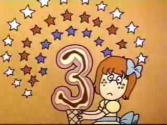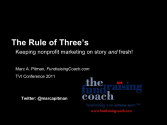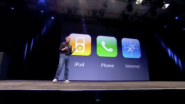-
About
- About Listly
- Community & Support
- Howto
- Chrome Extension
- Bookmarklet
- WordPress Plugin
- Listly Premium
- Privacy
- Terms
- DMCA Copyright
- © 2010-2025 Boomy Labs

Listly by Nick Kellet

Now we'll take a look at a classic self promotional marketing tool, The Rule of Threes. Keep the qualities of your effective offer in mind as you learn about this method of generating that most sought-after of marketing tools-word of mouth.

What's so magical about the number three? It's no accident that the number three is pervasive throughout some of our greatest stories, fairy tales and myths. It's also no coincidence that some of the most famous quotes from throughout history are structured in three parts, nor is it surprising that the Rule of Three also works wonders in the world of comedy.

This is one of the oldest of all the presentation techniques - known about since the time of Aristotle. People tend to remember lists of three things. Structure your presentation around threes and it will become more memorable. The Rule of Three - We remember three things.

In his book, Writing Tools: 50 Essential Strategies for Every Writer, Roy Peter Clark provides insights to the Magic of the Number Three: Use One for power. Use Two for comparison, contrast. (right - wrong, black - white, up - down, hot - cold) Use Three for completeness, wholeness, roundness.

Steve Jobs' presentations have become the stuff of legend. Inspired by his presentations, customers flocked to Apple stores waited in line for days to be the first to buy the newly released product. And his presentations left the media salivating over his every word.

A cognitive principle, which holds that things that are presented in 3's are easy to recognize and remember.

Former eBay (EBAY) CEO Meg Whitman is pushing three ways to revitalize California: create jobs, cut spending, and fix education. As she campaigns for governor, Whitman repeats those three themes in every interview, every advertisement, and on the home page of her Web site. Several people I've

The rule of three is powerful speechwriting technique that you should learn, practice, and master. Using the Rule of Three allows you to express concepts more completely, emphasize your points, and increase the memorability of your message. That's the truth, the whole truth, and nothing but the truth.

The Brain's Favorite Number Is "3″ Specialists in communication arts know it. Lawyers know it. Teachers know it. Parents know it. Marketers know it. Psychologists know it. You know it too, although you may not actually realize it. The brain likes to chunk what it takes in, in threes.

The Rule of Three's Keeping nonprofit marketing on story and fresh! Marc A. Pitman, FundraisingCoach.com TVI Conference 2011 Twitter: @marcapitman

Thomas Jefferson by Rembrandt Peale, 1800 This week America celebrates the three inalienable rights voiced in the U.S. Declaration of Independence: life, liberty, and the pursuit of happiness. Life, liberty, and happiness might very well be the three most important words in American history.

When we integrate content creation early in our web development processes, we are more effective at orienting our conversations to the end goals for the user and the business. This is a huge win for our users, who are increasingly demanding meaningful content experiences before they engage with our web sites and apps.

Chunking, in psychology, is a phenomenon whereby individuals group responses when performing a memory task. Tests where individuals can demonstrate "chunking" commonly include serial and free recall tasks. All three tasks require the individual to reproduce items that he or she had previously been instructed to study.

Have you ever heard of the Rule of Threes? It's a guideline used widely in writing and communicating that dictates your message is clearer and more effective when you can convey it in three parts. For example, in the Declaration of Independence, Thomas Jefferson wrote that every American had an inalienable right to "life, liberty and the pursuit of happiness."

The rule of Three is a writing principle that suggests that things that come in threes are inherently funnier, more satisfying, or more effective than other numbers of things. The reader or audience of this form of text is also more likely to consume information if it is written in groups of threes.

Lecture by Stephen J. Cannell WHAT IS THE THREE ACT STRUCTURE? Often, when I ask a writer this question I am told that it is a beginning, middle and an end. This is not the answer. A lunch line has a beginning, middle and an end.

A good presentation technique is the rule of three. The rule of three is based on the technique that people tend to remember three things. In oratory it comes up all the time. Good speeches are peppered with lists with three items 1. "Friends, Romans, Countrymen" - William Shakespeare in Julius Caesar 2.

Apply the Rule of Three to the middle section of your presentation. You build your talk in stages, and you make the case for your recommendation. Through all of this, the Rule of Three is the best method you can use. Yes, apply the Rule of Three . . .

Call it "the rule of three:" Refining business presentations to a few key messages will make audiences more likely to remember what you say ...ideas are best remembered when presented in threes. Every great speechwriter knows this. It's why Goldilocks did not encounter more bears. Three is easier to remember.

When I am deciding what presentation tip to share with you I often give you examples from personal experience because I give a lot of presentations but I also like to see what other coaches are suggesting. I was browsing the internet and came across this great article explaining the 'Rule of Three'.

Want to know how you can be unforgettable to employers? The answer is the "rule of three." Whether you're giving a presentation, telling a story, submitting a proposal or selling your services - keep in mind the "Rule of Three."

This article reviews a thought-provoking speech by Dan Pink about the surprising science of motivation, which was delivered at TED in 2009. Pink delivers a masterful speech which demonstrates many strong speech techniques, including: A powerful opening, which establishes a framework utilized throughout; Building of ethos and logos; Well-timed use of humor; Employing contrast and the rule of three; Powerful conclusion; and Superb delivery.

Most speakers know about the importance of using "The Rule (or Law) of Three." Most of us are not aware where it came from. We use this ancient mathematical law of proportion in ways we don't even think about. Abraham Lincoln learned it in his one-room schoolhouse.

It's simple, solid and effective: good speeches are peppered with lists of three items. Say it, stress it again and build on what was stressed. Like any great structure, the great spoken word is simple and repetitious.

Public Speaker explains why you should always group your presentation into memorable triplets of information.
